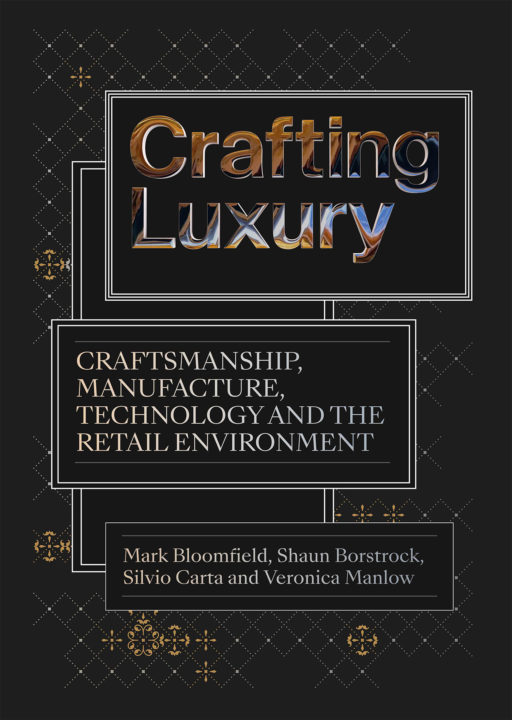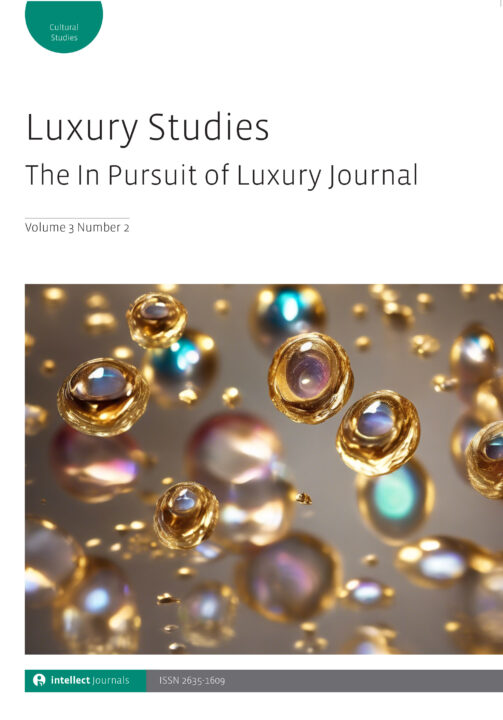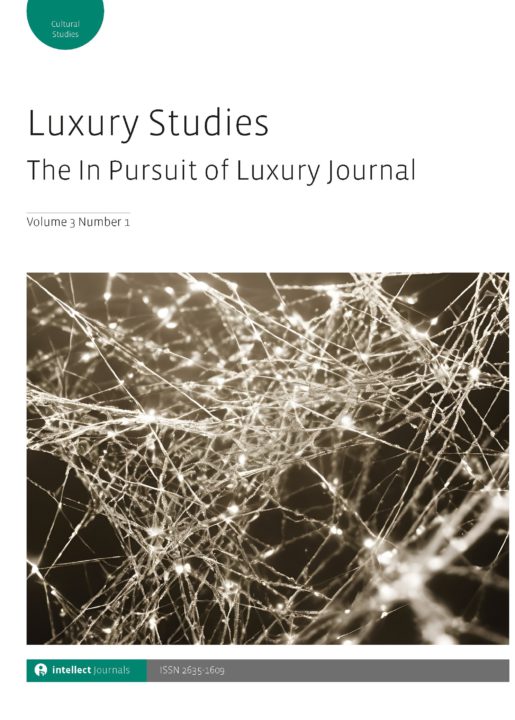Is there a new zeitgeist tapping on the shoulder of the luxury industry? If there is, certainly this new way of thinking centres around the theme of sustainability. In response, we see many actions taken by luxury brands, some misguided and others seemingly on target.
In the foreword, Gjoko Muratovski taps into this zeitgeist touched upon by Luca Solca in his article, recalling a vivid example which brings it to life for the reader. He recounts a story where American car executives are stunned when his students do not put forward a design that comports with their vision of luxury. Instead of using leather and wood for the interior they opt to outfit the vehicle with upcycled fabrics and reclaimed ocean plastic. When interrogated about these choices the student making the presentation boldly states that their idea of luxury does not include leather seats and wood panels which he says his generation deem to be ‘irresponsible and unsustainable’.
Issue 1.2 explores the ways in which luxury brands interpret the zeitgeist, from the micro to macro level, with sustainability as a central theme. Exclusivity, authenticity, craftsmanship, humanism, the luxury market and branding are themes covered in the research of our five authors and in the book review. In all cases the same question is posed: ‘what is luxury?’, whether in the broadest sense or in relation to a particular instance. The authors research, raise concerns and sometimes demand that luxury brands demonstrate their commitments to sustainability.
The articles in this issue start with one written by Solca, a luxury analyst at Bernstein. Solca explores risk and growth opportunities for luxury brands which rely so heavily on leather goods for profit, at a time when he sees shifts in views, expectations and behavioural patterns which for him signals a zeitgeist where sustainability is an essential component. New values impact consumption and he believes that this shift in consciousness can make leather products less desirable.
In Solca’s article we learn that major brands have taken significant steps to move towards an ability to replace leather partially or entirely. Will leather go the way of fur? One can envision a tango, with major luxury brands poised to move forward in tandem with customer sentiments. LVMH, Kering, Richemont and Hermès are preparing to lead should the music start to play – as People for the Ethical Treatment of Animals (PETA), for example, tries to raise awareness in a way that makes consumers feel an aversion towards leather. It remains to be seen if all but a small and well-to-do segment of the luxury market (a segment that, as Sara Emilia Bernat puts it, engage in ‘humanistic luxury’) will associate mycelium with fungus – something that, to some, seems repulsive, or will they not see leather as something which is retrograde or symbolic of suffering that needs to be replaced?
Partnerships have been forged with companies that provide alternatives to leather. Can iconic brands like Hermès replicate the properties of leather hides in handbags made of mycelium? Will Chanel simulate the exotic skins that they decided to forsake in 2018? The latest technologies that support circular processes are investigated and invested in. In a broader sense, with respect to sustainability and ethical positions, marketing is perhaps ahead of solid commitments. Branding reflects a shift to embrace social and environmental values. A will and a readiness to adopt some practices that allow for greater transparency are demonstrated but contradictions and gaps remain in an unequal patchwork as brands take a stance.
Juxtaposed to the careful documentation provided by Solca in the form of tables which demonstrate a variety of moves made by companies – which inform his assertions – we find Patrick Mathieu, a luxury consultant, researcher and author in partnership with sociologist and prolific author Frédéric Monneyron who chose to explore concepts associated with luxury that are much more elusive. While these concepts certainly can be quantified they chose instead a more interpretive approach which interrogates the notion of luxury as an image enacting its own rehabilitation. Luxury brands are in the business of creating symbolic structures that generate a desired response. An imaginary as Gilbert Durand speaks of it, is a repertoire of images and symbols creatively assembled into systems. Images of time and death are essential categories. Luxury today, Monneyron and Mathieu say, is ‘largely synonymous with brands’ and there are images that brands ‘arouse’ and additionally they say, one can look at how brands define life and death.
Death is a reality that luxury fights against. The authors speak of democratization as a potential death of luxury. If there is no poverty, can there be luxury? And if luxury brands themselves join a march towards a broader outreach, more products and greater accessibility – a democratization of luxury – is that the death of luxury? They seem to say that luxury brands give themselves a new mission as a means of evading an ‘act of death’. This mission gives a new face to luxury and insists on ‘preservation and sustainability’.
I am sure our readers would enjoy being around a table with Muratovski, Solca, Monneyron and Mathieu. They would be assured of fascinating conversation and a depth of analysis not commonly encountered in relation to the topic of luxury. Each brings his own knowledge and expertise. And there are other guests, whom we are about to meet, who could join in at this table, adding new layers of inquiry to the conversation.
While Solca focused on the key players in the global luxury goods sector and showed us how they are handling a perceived threat to doing business as usual with their reliably profitable leather goods, Mark Joseph O’Connell gives us an inside view of a smaller Canadian brand making high-end athletic wear. Arc’teryx, as one reviewer of this article put it, is unique and has its own culture and idiosyncrasies, which is what makes the case study method so compelling. We learn about how this brand deals with pressures, commitments and economic realities to demonstrate environmental responsibility. Timothy Lyttle, the brand’s marketing manager speaks of a shift amongst companies: ‘there is more of a recognition that companies have to be responsible for the products they are putting out into the market’. Outdoor wear companies seek opportunities to ‘showcase their values outside of the product they make’ by becoming involved with national parks and conservation efforts. Indeed, Arc’teryx’s marketing manager believes the brand has a responsibility to operate ethically and can demonstrate steps that they have taken in that direction. Arc’teryx is in O’Connell’s opinion following a holistic ethos (in alignment with Ursula Franklin’s call for radical change in industry and adoption of ‘holistic technologies’). A great deal of its less expensive products are manufactured in China but O’Connell tells those readers who might think this signals lower quality and less engagement in the manufacturing process, that this is not at all the case. Arc’teryx is a smaller brand but it is one of several Canadian brands whose aesthetic captures Canadian ideals and a Canadian identity, the dimensions of which O’Connell outlines for us in the article.
Bernat explores the ‘imaginary’ of humanistic luxury and continues to explore questions raised by Monneyron and Mathieu as had O’Connell. She starts out by saying that humanistic luxury is an oxymoron, a paradox, and yet it is a new trend, a consumer segment and an arena in the luxury sector. How did it emerge, where is it positioned and what are its implications? To find the answers she returns to traditional notions of craft and artisan production and rarity. She sees humanistic luxury as a ‘remoralization’ of consumption in direct relation to social pressures and environmental issues which are at the forefront of public discourse. Major brands take up certain subjects and leave others aside. Luxury brands understand the need to align themselves with the most relevant values and to a degree to reinvent themselves while still adhering to core values. In seeking answers about the emergence of luxury fashion brands which subscribe to a humanistic approach (Brunello Cucinelli would be one well known example – Cucinelli is influenced by Catholic social thought and sees his company’s mission as one of stewardship, leading to a variety of projects such as the building of hospitals) and whose main focus is doing good through ‘prosocial transformation’ such as supporting unknown rural artisans who otherwise would be impoverished, Bernat turns to a sample of fourteen luxury consumers to ask them about their own humanistic luxury purchasing. These consumers select brands that are committed to doing good, that embrace democratic values and which often claim to represent an authentic view of luxury. The newer brands that she discusses in her article are sold exclusively online, most often on Instagram. Her interviews give us insight into a consumer who might buy the mycelium handbag and leverage this purchase in her social circles. Engagement with these brands supports an ideal self and allows one to reconcile a desire for exclusive and high-priced luxury items with progressive values and a sense of oneself as an activist. Bernat speaks of consumers as being embedded in a web of social connections. These humanistic luxury consumers are inclined to denigrate companies and individuals who do not embrace their values. Should they be influencers, their judgements and proclamations can lead to a new level of awareness, perhaps to shame and this in turn can bring about behavioural changes around luxury consumption.
Thomai Serdari explores the notion of zeitgeist throughout her book, Rethinking Luxury Fashion. Karl Lagerfeld is an example of a designer and creative director who used a culture-based creative strategy drawn from an understanding of the zeitgeist to advance Chanel to new levels of fame and economic success more than a decade after the passing of its founder. His understanding of the heritage and symbols associated with the brand were integrated with new silhouettes and forms of expression drawn from art, film and music which influenced his designs and informed the presentation of the brand in its communications, on the runway and in flagship stores. Fr Andrew O’Connor in his review of Serdari’s book, speaks of her commitment to studying brands as material culture producers. Serdari believes successful luxury brands use cultural intelligence to engage with consumers and adapt their creative and design strategies accordingly. Intuition leads brands forward. We see this in Solca’s article as well. While brands must rely on metrics they also need to intuit social and cultural forces. Serdari says that they need to pay attention to social shifts. Perhaps they sometimes hedge their bets: they will continue to profit by selling leather while working out the mechanism to survive without it? Production of luxury is dependent on a brand’s creative strategy, something that Monneyron and Mathieu identify through the notion of the imaginary. In this book review we tried something new: reviewer meets author after completing his or her review.
With Shaun Borstrock’s interview of milliner Stephen Jones we encounter what one might say is an authentic crafting of luxury. The focus indeed is on the craft and not on imagery alone or on enacting a notion of luxury which may or may not be rooted in something that is genuine. Borstrock invites us into the atelier where it is technique that matters. Says Jones: ‘Any designer fashion is luxurious and it is luxurious because they use good quality materials. But that level of technique taking it to another level, no, they don’t have the creativity with materials nor the technique’.
We are confronted with talent and vision and an acute understanding of the moment one inhabits, of cultural forces as well as a full range of historical references which come from experience working with the houses of Dior, Balenciaga and with designers Zandra Rhodes and Azzedine Alaia. Indeed we find intuition to be a cornerstone of Jones’s work, a key element in iconic design which Serdari spoke of so prominently in her book. Jones tell us that there are only two or three milliners in the United Kingdom, two in France, none in Germany, one in Italy and two in Japan and only three or four design houses or milliners and about ten people in total, in the world, who can make hats that compare to what he does in his studio.
Muratovski might ask if this supreme level of craftsmanship can do good while also being so spectacular. Jones explains that his hats use small amounts of materials. Hats in general are imbued with significance. They are not thrown away, they are repaired and remade.
In our inaugural issue we spoke of a commitment to include topics related to luxury that have not been covered sufficiently and to include a diversity of voices. In this issue we have practitioners, professionals with diverse backgrounds who shape the luxury sector through their innovations in design and who are engaged in analysing, advising and critically evaluating the actions of brands joining with scholars in disciplines as varied as sociology, art history and archaeology, communication and culture and creative arts who explore luxury as a multifaceted phenomena and whose work presents opportunities and pathways for advancement and change. We also have a parish priest who is also a fashion designer, artist and founder of a truly humanistic luxury company, Goods of Conscience. I do look forward to the day when all these individuals will be seated together, in conversation. Perhaps that moment can be at the next In Pursuit of Luxury Conference, to be held in London in May 2023.





